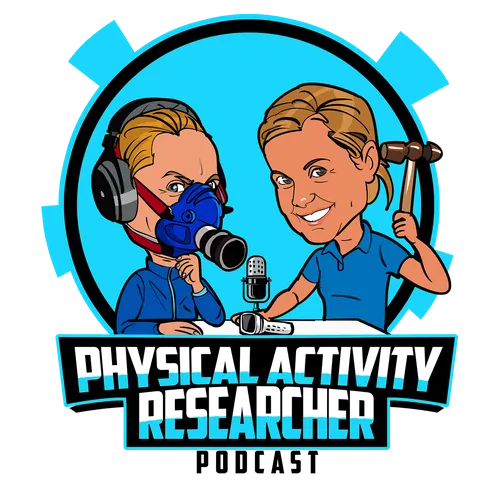
Physical Activity Researcher
The source of the latest research findings in all things related to physical activity, exercise and health. World-renowned experts as guest. Includes Meaningful Sports and Practitioner‘s Viewpoint Series.
- Update frequency
- every 2 days
- Average duration
- 25 minutes
- Episodes
- 623
- Years Active
- 2020 - 2025

How to Reduce Skin Irritation in Long-Term ECG and HRV Measurements – José Näf (Pt4)
Can electrode design support both signal stability and sustainability?
José Näf explains how Nahtlos electrodes reduce waste and skin irritation while delivering high-quality data over time.
In this …

Electrode Innovations: Self-Humidifying Electrodes for Long-Term HRV and ECG Measurements– José Näf (Pt3)
Can electrode systems self-regulate moisture to keep data quality high for 10 days?
José Näf explains how Nahtlos’ innovative design improves both signal stability and skin comfort in long-term ECG a…

Supervised Learning in Physical Activity Research _ Next-Gen Research Techniques
🎙️ Supervised Learning in Physical Activity Research – Unlocking Insights from Accelerometry Data
How does supervised learning enhance physical activity research?
In this episode, we dive into superv…

How to Select Participants for an Experience Sampling Method (ESM) Study: Sampling Techniques _ Next-Gen Research Techniques
🎙️ Selecting the Right Participants for ESM Research – Why It Matters!
The success of an ESM study depends on choosing the right participants. Here’s how to do it effectively.
In this episode, we dis…

Highlights / How to Measure Sleep? Dr Jesse Cook (Pt2)
Jesse Cook is a PhD candidate in the Dr. David Plante Sleep Research Laboratory and studies biological, psychological and sociological factors that connect with unexplained excessive sleepiness.
He w…

Overcoming Common Challenges in Experience Sampling Method (ESM) Research _ Next-Gen Research Techniques
📢 How Can Researchers Overcome Common Challenges in ESM Studies?
Participant fatigue, low response rates, and data inconsistencies can threaten ESM research—here’s how to tackle them.
In this episode…

Tricks to Get Better HRV and ECG Signal Quality - How Electrode Placement, Shirt Material, Impedance Affect ECG and HRV Data – José Näf (Pt2)
Does clothing material affect ECG signal quality?
José Näf explains how electrostatic effects, electrode placement, and connector design influence long-term HRV and ECG data accuracy.
In this second …

How to Choose Electrodes for Long-Term HRV and ECG Measurements – Insights from José Näf (Pt1)
Dry electrodes often promise convenience, but why do they so often fail in long-term heart monitoring?
José Näf breaks down the science and business behind electrode design for ECG and HRV tracking.
…

Highlights / What is Sleep? Dr Jesse Cook (Pt1)
Jesse Cook is a PhD candidate in the Dr. David Plante Sleep Research Laboratory and studies biological, psychological and sociological factors that connect with unexplained excessive sleepiness.
He w…

Introduction to Machine Learning in Physical Activity and Health Research _ Next-Gen Research Techniques
🧠 Can AI Unlock New Insights in Health Research?
Machine learning is changing the way we analyze physical activity—revealing patterns and predicting health outcomes like never before.
In this episode…

Illuminating the Future: How Photoplethysmography (PPG) Sensors are Revolutionizing Health Monitoring _ Next-Gen Research Techniques
💡 Can Light-Based Sensors Revolutionize Health Monitoring?
Photoplethysmography (PPG) sensors are reshaping how we track heart health—non-invasively, in real time, and from anywhere.
In this episode,…

Highlights / Interesting Ideas How to Analyse Sleep and Physical Activity Data - Dr Christina Reynolds (Pt3)
Christina Reynolds, PhD
Christina Reynolds received her Ph.D. in astrophysics from University College London and a Master's degree in software engineering from Harvard University. She has been a Data…

How to Improve Compliance in Experience Sampling Method (ESM) Data Collection _ Next-Gen Research Techniques
📢 How Can Researchers Improve Compliance in Experience Sampling Studies?
High-quality ESM research depends on participant engagement—so how do we keep compliance rates high without overwhelming them?

How Posture, Activity, HRV data with AI Are Enhancing Heart Function Research _ Next-Gen Research Techniques
🧠 Can AI and Wearables Transform Heart Function Research?
From posture to activity levels, new AI-driven insights reveal how daily movements shape cardiovascular health.
In this episode, we explore h…

Highlights / Intradaily Variability and Interdaily Stability as a Measures of Circadian Rhythm - Dr Christina Reynolds (Pt2)
Christina Reynolds, PhD
Christina Reynolds received her Ph.D. in astrophysics from University College London and a Master's degree in software engineering from Harvard University. She has been a Data…

Health Insights with Multi-Biosignal Monitoring and Machine Learning: A New Era in Real-World Research _ Next-Gen Research Techniques
📡 Can Machine Learning Unlock the Full Potential of Wearable Health Data?
Multi-biosignal monitoring is revolutionizing research, capturing heart rate variability, ECG, oxygen saturation, and more—no…

Future Trends and Advancements in Machine Learning for Physical Activity Research _ Next-Gen Research Techniques
🚀 How Will Machine Learning Shape the Future of Physical Activity Research?
From deep learning to real-time feedback, AI is set to transform how we track, analyze, and personalize health insights lik…

Highlights / Why Every Research Team Needs an Astrophysicist! Sleep, Circadian Rhythm, EEG... Dr Christina Reynolds (Pt1)
Christina Reynolds, PhD
Christina Reynolds received her Ph.D. in astrophysics from University College London and a Master's degree in software engineering from Harvard University. She has been a Data…

Experience Sampling Method (ESM) – Comprehensive Guide to Researchers _ Next-Gen Research Techniques
📊 How Can We Capture Human Experience in Real Time?
Traditional surveys rely on memory, but what if we could collect thoughts, emotions, and behaviors as they happen? That’s the power of the Experien…

Comparing Supervised and Unsupervised Learning in Physical Activity Research _ Next-Gen Research Techniques
🚀 Supervised learning predicts outcomes, while unsupervised learning uncovers hidden trends—but what happens when we combine them?
Machine learning is transforming physical activity research, but cho…